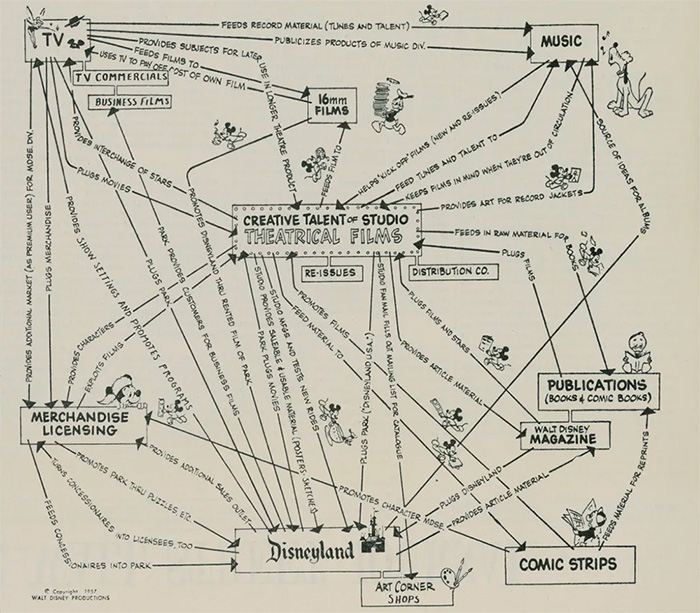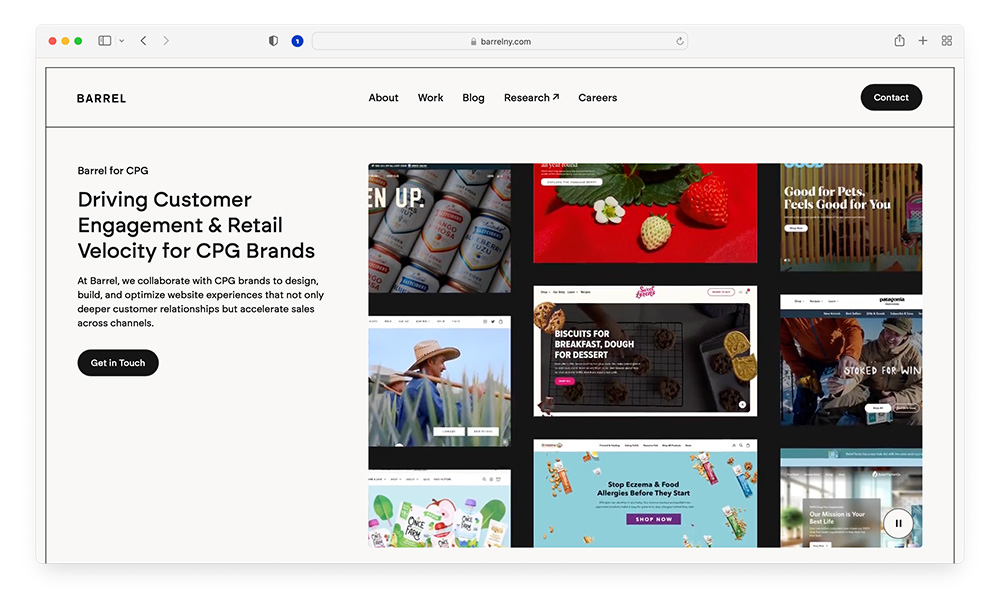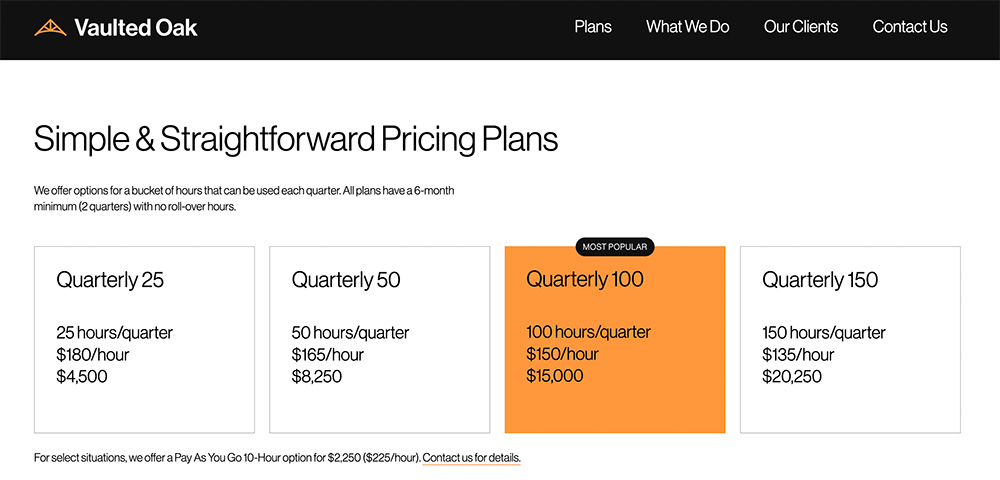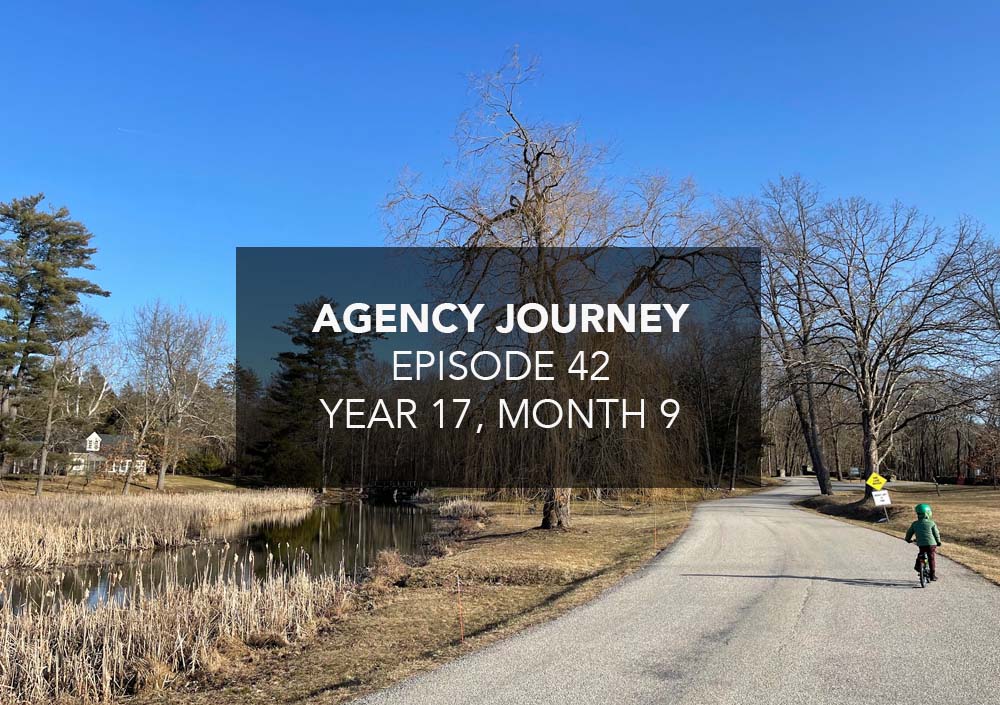I’ve been enjoying a biography of Walt Disney, Walt Disney: The Triumph of The American Imagination by Neal Gabler.
I’m about 80% through and one of the things that struck me is how, for the first twenty or so years of the business, Disney struggled financially and came very close at multiple points to losing it all as an animation/movie studio. The financing of animation movies was risky business and it took a combination of big hits (Snow White, Cinderella) and willing lenders (Bank of America) for Disney to avoid complete ruin. They struggled with cost overruns, box office bombs, and of course big macro events like World War II.
Founder Walt Disney seemed to have been burnt out multiple times in the movie business. He became obsessed with model trains and miniatures, and it was his desire to do something other than movies which led to the creation of Disneyland, the amusement park concept that would be the cash cow for the business, doing for it what movies and television hadn’t been able to.
Over time, Walt Disney would realize some incredible synergies between the theatrical films, television, merchandise, music, amusement park, and other properties. This was forever immortalized in a 1957 corporate diagram which laid out the Disney empire:

Walt Disney’s story as an entrepreneur inspires me. What I learned from the biography is that he actually didn’t have a thought-out master plan from the start but that by constantly experimenting, being an early adopter of new technology & mediums (e.g. movies with sound, TV, etc.), and pushing for something that would delight his customers, Disney found ways for his business to survive and eventually thrive.
About Agency Journey: This is a monthly series detailing the happenings at my agency Barrel, founded in 2006. You can find previous episodes here.
Highlights
Keeping Busy with Positioning and Marketing Around CPG Food & Bev
This past month was filled with various activities that we believe will pay off in the long run. One angle we are pursuing is to position Barrel as an expert firm that helps CPG food and beverage brands get the most out of their website, not only via their direct-to-consumer e-commerce, but by generating greater brand awareness, building direct relationships with customers, and driving traffic to their other channels (in-store retail, Amazon, restaurants, etc.).
Having worked with dozens of CPG food & beverage brands over the years (KIND Snacks, Hu, Once Upon a Farm, Patagonia Provisions, Soylent, Gimme Snacks, Austin Eastciders, just to name a few), we believe we can differentiate through our Shopify e-commerce know-how as well as our skills in retention marketing, personalization, and analytics. We continued our work with our positioning, honing in on our POV as well as tangible services we can offer to brands.
The challenge will be to deliver enough value that we can exist alongside the Amazon-focused agencies that are quickly dominating the share of e-commerce activity. Many of our clients don’t see their owned DTC e-commerce as a growth driver with some shutting down the channel completely, but our pitch is that with or without owned e-commerce, the website still has an important role to play in supporting all the other channels.
We designed a landing page specifically for CPG brands (inclusive of personal care, beauty, and supplements) to help articulate our POV along with relevant case studies.

We created a landing page showcasing our CPG focus along with our POV and relevant case studies.
With this positioning in mind, we’ve been busy brainstorming and making plans to market ourselves to the right audience. While we won’t be able to make it to Expo West this year (the premier natural foods conference), we’re investing in some upcoming marketing efforts including a joint webinar with natural food and wellness marketing agency SRW hosted by The Food Institute. We’re also making weekly efforts to connect with entrepreneurs and investors in the space, learning from their experiences and also testing out our positioning with them.
We’ve added four new food and beverage clients over the past 3 months. We aim to keep the momentum going, continually improving and expanding services to better retain existing clients and to attract new ones. A stretch goal for the next 10 months is to add 10 more (1 per month) such clients to our roster.
Potential Acquisitions for Barrel
We’ve been having a several conversations over the past few months with agency owners about potential acquisitions. The simple explanation is that we’re trying to grow Barrel by acquiring a smaller agency. But there are some nuances to this. The range of opportunities we see, depending on the agency, are:
- Teaming up with capable leaders who are excited to grow with us long-term.
- Filling some talent needs we have, especially around business development, strategy, and engineering.
- Introducing complementary skills that can help us quickly expand our services offering.
- Adding key client accounts that we can grow through effective account management.
- Increasing our lead volume and network for new business opportunities.
We’re typically looking for agency businesses doing $1-$2 million in revenue with founders who are either looking to exit the business completely or are interested in joining us for the long-term. We began with a focus on Shopify-only firms, but we’ve since expanded to include agencies with complementary services such as SEO, paid, and retention marketing.
Since we’re under NDA with folks who are farther along in conversations with us, I won’t be alluding to any specifics and will not bring this up as much in the future (unless we complete a deal and can talk about it publicly), but if you or anyone you know are interested in selling, please hit me up.
It’s been a fun process, I’m learning a lot, and we’re getting better at building processes to keep things moving. If we can do one deal this year, I will see that as a major accomplishment and something to build upon.
Simplifying Our Ongoing Offering Across the HoldCo
With our Webflow agency BX Studio and our brand design studio Bolster, we experimented with a subscription offering for ongoing services.
The subscription model for services has become a popular approach for small firms and solopreneurs offering “unlimited revisions and requests” for a monthly fee. The “unlimited”, however, is more marketing than a true benefit – each request takes a few business days to turn around, so in a 30-day month, you’re talking about somewhere in the ballpark of 6 to 10 requests. In many cases, if the request feels big (e.g. “build me a new homepage”), it might be the only request for that month.
Some firms have tried to work around this with pricing that allows for more than one request at a time. So you can be working on the homepage for the entire month while also servicing other smaller tasks (e.g. “add this tracking script to my site”). Also note that I may be grossly oversimplifying some things since I haven’t observed directly how these firms work and am making guesses based on our own experiences and from what I can glean from their websites. I did take a look at the finances of a company using this model once and the biggest flag was high percentage of client churn after 1 to 3 months.
While this model may work for some, we found it a challenge to get going in an efficient way. The main issue was that our subscription pricing was too low, which meant we could never dedicate too much of a resource to one client and always had to weigh limited bandwidth with delivering just enough to keep clients happy. Not a great setup for maintaining a long-term relationship. We contemplated raising the price, but knew that would be a dealbreaker for the clients we typically service.
We didn’t have to look far for a proven model that would be a better fit. Our website support & maintenance agency Vaulted Oak has been offering a handful of very simple plans since the start. These are quarterly buckets of hours that clients can use throughout a 3-month period and automatically renews every quarter unless they opt out. The plans range from as low as 25 hours to 150 hours per quarter. Some clients will start with 25 hours and then scale up every now and then to 100 or 150 hours if there are new initiatives and complex functionality additions to their website.

Vaulted Oak’s quarterly plans have been there from Day 1 and been an effective way to keep clients long-term.
We’ve adopted and begun to engage BX and Bolster clients with similar quarterly plans, and these have proved to be much more straightforward in both selling and management. We help clients get a sense of the hours certain tasks will take and also spend some upfront time roadmapping or listing out priorities. This helps to provide some clarity on how hours will be used.
There’s a beauty to having a diverse portfolio of clients on quarterly plans, especially plans that do not feel prohibitively expensive for the client while also feeling indispensable. These can become sticky sources of recurring revenue, laying down a strong foundation for the business. Provided you can service all of these clients profitably (which requires vigilance in operations and cost management), having a large percentage of revenue come from these plans can set us up for long-term success.
Top of Mind
Talent, Talent, Talent
One thing we can never lose sight of is the importance of talent. Having quality people in the right roles working on the right things is critical.
It’s easy to lose sight of this when business is slow and the team isn’t fully utilized. We had a few months where lack of new wins, delayed new business signings, and project overruns led to financial underperformance. In such a situation, looking for talent is usually the last thing that’s on our minds, but more and more, I believe it is precisely the time to continue with proactive recruiting.
The key distinction is that recruiting doesn’t necessarily mean adding to headcount and payroll right away. It’s about meeting new people, getting a sense of who is out there, and giving ourselves some optionality. Maybe we get notice of an unexpected departure of key team member. Maybe we suddenly land three new projects at the same time and are short-staffed. If we’re regularly attracting applicants, sifting through them, and having preliminary conversations, we’re in a much better spot than if we were to have done nothing at all. Even better if we went a step further and tested some candidates on real projects (most likely a freelancer or someone open to moonlighting).
One additional benefit to proactive recruiting is that we can then be bolder in our performance management. Too many times, we’ve shied away from engaging in performance improvement plans or outright performance-related firings because we feared that it’d be too much work and disruption to replace someone. In hindsight, ten times out of ten, we are reminded that we should have made the move sooner, regardless of the fallout. An active pipeline of talent can embolden us to take swift action when necessary, knowing there are qualified candidates ready to step in.
For larger companies with a built-up talent management practice, many of these things are a given. In fact, HR professionals make the distinction between recruiting (filling for volume and short-term needs) and talent acquisition (more strategic, hard-to-fill hires, and overall employer marketing to attract candidates). However, for small agency businesses like ours, it’s often a conscious decision you have to make and an extra investment that may not feel great in the short term.
In recent months, we’ve taken proactive recruiting to heart. Some of the things we’re doing include:
- Getting set up with Contra to have better organization and visibility into our contractor network. Their team has been fantastic, and after a 1-month trial, we’ve committed to moving our contractor management (previously done loosely on spreadsheets) to the platform.
- Working with a freelancer to help process inbound applicants, winnow down to qualified candidates, conduct first round of interviews, and to schedule meetings with our hiring managers. This is something we desperately needed because otherwise our hiring managers would be bogged down with hours of resume reviews. The key here is for the hiring manager to clearly articulate what they’re looking for and to work with the freelancer to create a repeatable process.
- Setting aside budget to try freelancers out on real projects, even if they may be redundant or needed for just part of the project. We’re making the bet that seeing someone in action on a real project can be a much more effective vetting process.
Because we’re investing in making our freelancer network more valuable, we also need to ensure that we have personnel who are good at managing freelancer talent. I’m not talking about having more managers but having organized, communicative, and proactive team members across all of our disciplines who can play important roles in coordinating collaboration with the freelancer network.
In this way, the agency might evolve to be smaller in full-time W2 headcount but a higher percentage of these employees will be very capable at project strategy and management, enabling us to get leverage via the freelancer network–a core team of 25 to 40 people being able to output the work of an agency that in the past would have had to be 100+ full-time W2 employees. We see this happening at a smaller scale with Vaulted Oak and BX Studio, and it’s worth trying to make it work for Barrel. It all starts with being proactive.
Shared with Partners
“The first thing that will catch my attention is your preparation. There is little so off-putting as someone who begins the meeting by asking me some basic facts about my company or situation that she could have found out in advance. It not only reveals laziness, but makes me feel like one more ‘cold call.’ You don’t have a special interest in me, you’re on a fishing expedition, trying to drum up some revenues. On the other hand, someone who can say ‘I noticed from your annual report that you recently opened a new plant. What has that meant for your department?’ has caught my attention. It may not have been intellectually challenging to read my annual report, but it shows that you do your homework. It tells me something about you.” (David H. Maister, Managing the Professional Service Firm)
This excerpt is a great reminder to do our homework before having conversations with our clients. Sometimes, especially for smaller private companies, a lot of information is not publicly available, but we can still make the effort to see if there’s anything we can glean from their website content, a quick Google search, or their social media accounts. More specific to us, take a peek at their analytics (if we have access) or running a few scans like site speed or SEO might be better than nothing.
“Sales speed up. This problem here is not obvious, but it is insidious. As your income climbs, expenses quickly follow. Big deposits feel great, but they are irregular. Consistent incoming cash flow is hard to sustain. A great quarter can trick you into believing your business is on a permanent upswing, and you start spending like this is the new normal. But drought periods come quickly and unexpectedly, causing a major gap in cash flow. And cutting back on expenses is nearly impossible because our business (and personal) lifestyle is locked in at our new level.” (Mike Michalowicz, Profit First)
This has got to be one of the most common stories of pain and hardship for agency owners. The quick growth followed by expansion of costs and then the slowdown (or contraction) that puts immense amount of pressure on sales. I have many thoughts on ways to deal with this (having learned lessons the hard way), but I’ll save it for another time.
“The greatest enemy of truth is the innate desire to win every argument. Learning is what happens when you end up justifiably agreeing with people who disagree with you.” (Gautam Baid, The Joys of Compounding)
Being able to tamp down on your ego is a big unlock for growth. There is little to no upside in trying to win an argument. Better in most situations to concede or go for some kind of win-win compromise. Even a “I don’t agree, but I can see how your POV makes sense” is likely to be more productive.

Recently landed on your blog while searching for owner compensation. Your journey is so relatable and I am glad that you are documenting it. I am a co-founder for an agency based out of Toronto. Looking forward to more.
Thanks, Ahmed!